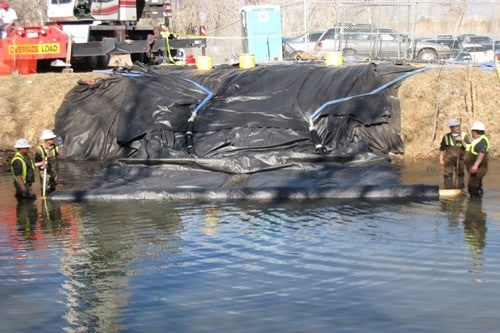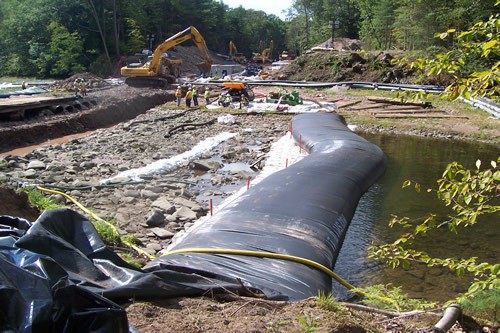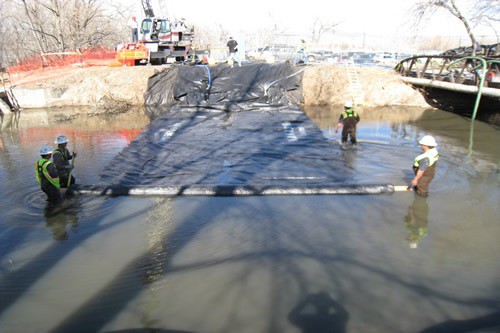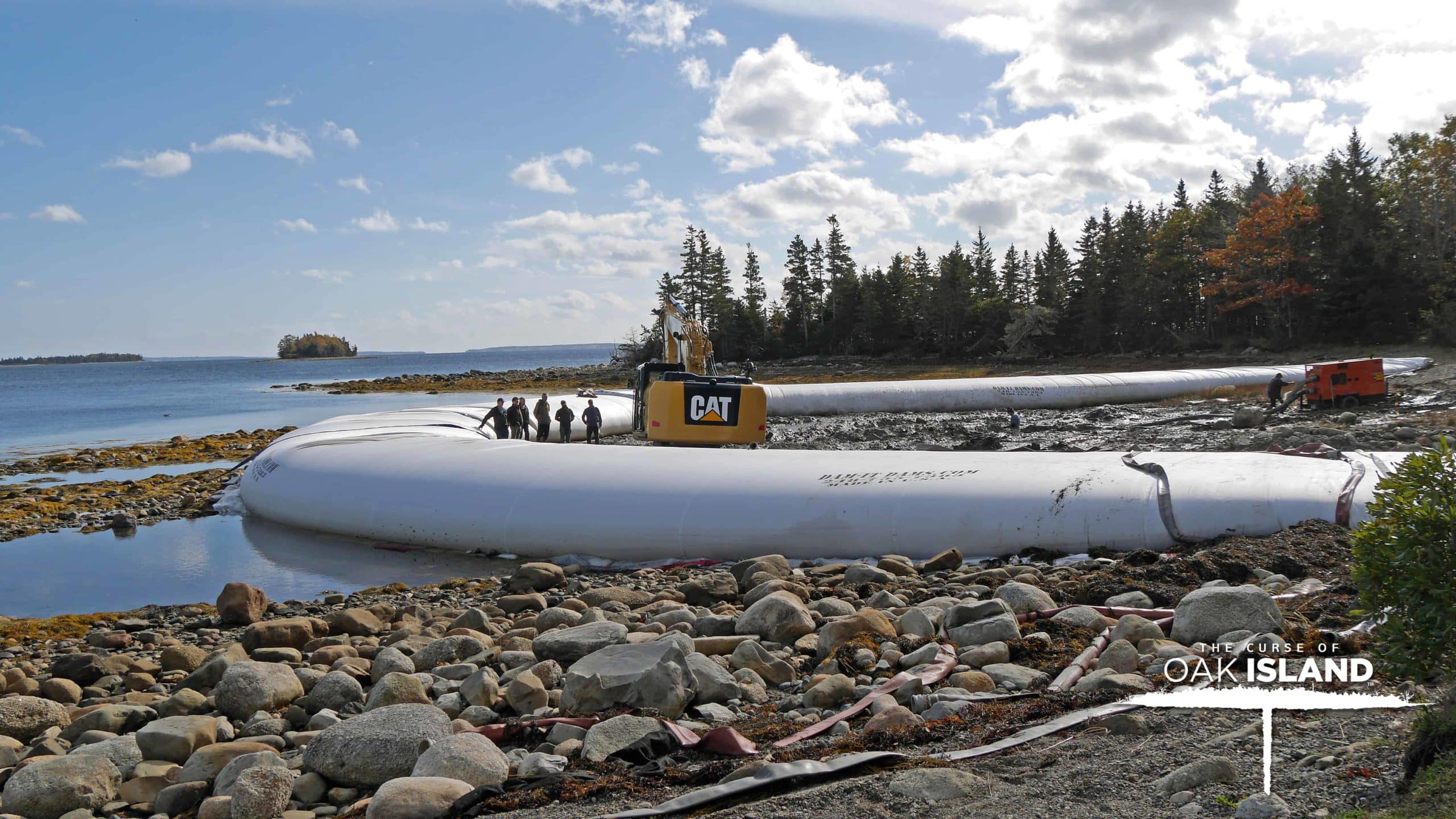Cofferdams (also coffer dams) are a temporary enclosure in or around a body of water that is constructed to allow dewatering, diversion or damming of an enclosed area. The primary purpose of cofferdams are to create a dry environment for a project to proceed. They were first used in 1736.
Today’s coffer dams are typically conventional embankment dams of both earth- and rock-fill, although concrete or some sheet piling also may be used.
There is a company headquartered in Michigan – Dam-It Dams, Inc. – whose dams use on-site water to fill dual inner tubes that cause the dam’s chambers to slowly and evenly inflate, forming a strong, stable cylindrical tube. As the inner tubes continue to fill and the water pressure builds, the dam unrolls in a controlled manner to create cofferdams.


There are as many water-control applications as there are types of cofferdam. Dam-It Dams’ patented, portable, water-filled Cofferdams offer effective and cost-efficient solutions for these major types of situations that are called the 3-Ds of water control:
Dewatering:
Dewatering, unwatering and water control are common terms used to describe the removal or drainage of ground or surface water, typically on a construction site. Dewatering is often required before subsurface excavation for such things as foundations, shoring, cellar space and repairs to existing water structures.
Diversion:
Diversion is the temporary (or sometimes permanent) re-routing of water. It may be required to initiate a project and/or allow a project to proceed.
Damming:
Damming is the process of creating a barrier that holds back water. The barrier may be needed to maintain water table levels, collect water for storage and prevent water from crossing established/safety thresholds.
Because Dam-It Dams’ Cofferdams work with Mother Nature, not against her, they create effective water barriers that leave no – or only a minimal – footprint on the environment. And, their Cofferdams are industrial strength and reusable to minimize additional investment costs.
What to Look for in a Contractor
Selecting a contractor (or contractors) to manufacture and install a cofferdam to meet your specific needs is one of the most important decisions you will make to ensure the success of the project.
There are several factors to be considered:
Number of Contractors
- One contractor for manufacture and installation?
- One contractor for manufacture; another contractor for installation?
- One contractor for manufacture; self installation?
- One contractor for manufacture; self installation with contractor supervision?
Cofferdams Size
- Does the contractor offer coffer dams in the size(s) you need?
- Can the dams be manufactured and delivered to meet project timing?
- Are the dams water filled?
Equipment Needs
Who will provide the following equipment that is recommended for large cofferdam installations?
- At least two portable 2″-3″ water discharge pumps. Using more pumps will lessen fill time. The inner fill tubes will accommodate any size discharge hose,
- A discharge/suction hose for each pump
- Duct tape to secure and constrict the fill tubes
- Restraining ropes
(In moving water, restraining ropes should be used to help control the dams during installation. Every 100 feet of cofferdam require 250 feet of 1/2-inch rope. The use of four ropes is highly recommended for the installation of cofferdams that are six feet or higher in rapidly flowing water.)
Project Personnel
Who will be responsible for provide the following project personnel?
In Stationary Water
Two to four workers are typically required to install small (less than 4 feet in height) cofferdams in stationary water.
Three to six workers are typically required to install large (4 feet or higher) cofferdams in stationary water. Ropes are usually not needed but can be used to maneuver the dams in deep water depths.
In Moving Water
Three to seven workers are required to install small and large coffer dams in moving water. The following table shows personnel needs for typical installations of coffer dams in moving water:
| Cofferdam Size (feet) | Ropes | Workers in the Water | Workers Manning Pumps |
| 1-4 | 0 | 1-3 | 1 |
| 4 | 2 | 2-4 | 1 |
| 6 | 3 | 2-4 | 1 |
| 8 | 4 | 2-4 | 1 |
| 10+ | 4 | 2-6 | 1 |
Strong water currents require more personnel to ensure proper installation and the safety of all workers.
Site Preparation
Who will be responsible for preparing the site, including moving or removing boulders, rocks and debris that may interfere with proper installation of the cofferdam and, if necessary, leveling the water bed?
Need Help?
Dam-It Dams, Inc. is the Midwest’s Largest Manufacturer of portable water-filled cofferdams. If you need help or have any questions about the manufacture or installation of cofferdams, please contact us at (248) 755-7383.
Cofferdam Installation
Cofferdams are a temporary enclosure in or around a body of water constructed to allow the enclosed area to be pumped out, thus creating a dry environment for work activities to proceed.
Cofferdams were first used in 1736. Today’s cofferdams are typically conventional embankment dams of both earth- and rock-fill, although concrete or some sheet piling also may be used.
Dam-It Dams’ Cofferdams are easy to install. On-site water is pumped into the two fill tubes causing the dam’s chambers to slowly and evenly inflate, forming a strong, stable cylindrical tube. As the inner tubes continue to fill and the water pressure builds, the dam un-rolls in a controlled manner to create a dam.
Contractors find the layout easy to adapt. Our Cofferdams can be molded perfectly to fit a lake bed, river bed, watershed or any other type of physical setting.
Using the available extension coupling system, individual dams may be easily linked together to create a watertight barrier.
How To Install Dam-It Dams Cofferdams
There are eight basic installation steps:
Step 1. Rolled-up Cofferdams are delivered to the job site on a truck or trailer.
Step 2. Cofferdams are transferred from the vehicle to the shoreline.
Step 3. Two identical pumps are connected to the Cofferdams to fill the internal tubes with on-site water.
Step 4. As the Cofferdams fills with water, it unrolls and is guided into position.
Step 5. The Cofferdams inflates as it reaches the opposite shoreline.
Step 6. Water is pumped from one side to the other side of the Cofferdams to create a “dry zone.”
Step 7. Project work commences on the dry side.
Step 8. Upon project completion, the Cofferdams are drained, rolled up, put back on the truck/trailer and moved to the next site.
Dam-It Dams, Inc.
There is a company in Michigan – Dam-It Dams, Inc. – that has been an innovator in cofferdams and other water solutions since 1928.
Dam-It Dams’ patented, water-filled portable Cofferdams create effective water barrier dams that leave no or only a minimal footprint on the environment. Our dams work with Mother Nature, not against her. And because of their industrial strength, our Cofferdams are reusable.
The Company’s patented portable Cofferdam System™ offers a cost effective and highly adaptable solution to manage, move, dam or divert water with minimal or no impact on the environment. The easy-to-install System uses on-site water (versus outdated sand bags and earthen fill) to eliminate waste and harm to the land. The System is reusable and may be purchased or leased. Contractors may use our professionals or their own workers for installation to save time and money.
Cofferdams Manufacturer Wins Most Innovative Product Award for Portable, Water-filled Dams
Grand Blanc, Mich. – Coffer dams are probably not a frequent topic of conversation in most circles, unless you work for a company that has dedicated its entire existence to developing eco-friendly water control solutions. That dedication paid off when the company received the “2013 Most Innovative Product (MIP) Award” at the annual World of Concrete Convention held this year in Las Vegas.
The MIP Award Program is sponsored by Hanley Wood, LLC – the premier media, information and marketing services company serving the residential, commercial design and construction industries. The Program gives attendees and audiences at the annual Convention a chance to vote for the products they judge to be most innovative. A panel of industry experts then reviews and selects the MIP Award winners.
For the second year in a row, Grand Blanc-based Dam-It Dams, Inc., won the prestigious MIP Award in the General Tools & Equipment category. The Company’s Portable Water-filled Cofferdams systems were an “Industry Choice Winner” this year and an “Editor’s Choice Winner” in 2012.
“This is a real honor for us, especially winning last year and again this year” said Jack Nichols, President of Dam-It Dams. “We’ve traveled around the country and the world to implement the best solution for each challenge. To be recognized by our customers and our colleagues in this way is really special.”
Since 1928, Dam-It Dams has been an innovator in cofferdams, which are temporary water barriers that allow the enclosed area to be pumped out, thus creating a dry environment for work activities to proceed. First used in 1736, most of today’s cofferdams are typically conventional embankment dams of both earth- and rock-fill.
Dam-It Dams’ patented portable Cofferdams, on the other hand, use on-site water to manage, move, dam or divert water with minimal or no impact on the environment. The Company’s wide selection of various types of cofferdams offers a cost effective and highly adaptable solution for virtually every contractor’s need.
For more information, go to damitdams.com.
Cofferdams System
What are Cofferdams System?
When there is a need to temporarily control the movement of water – whether through damming, diversion or dewatering – most contractors agree cofferdams (also coffer dams) are the best alternative. Why? Because they are readily available in numerous configurations, easy to transport and install, cost efficient and environmentally sensitive.
Coffer dams then self are one of the five parts that comprise a typical Cofferdam System:
- Coffer dams – a flexible yet durable water barrier made of high technology materials
- Water discharge pumps (2) – to draw in on-site water to inflate the cofferdams
- Discharge hoses (2) – to transport water to and from the cofferdams
- Restraining ropes – to assist with the unrolling and positioning of large cofferdams systems
- Connections – to couple together two or more cofferdams


This standard type of cofferdams systems not only provides a way to avert or at least minimize flooding damage but also gives project managers a solution for many of their challenges.
Cofferdams System Applications
There are dozens of applications for cofferdams systems. Dam-It Dams’ patented, portable, water-filled cofferdams offer effective and cost-efficient solutions for these major types of situations that we call the 3-Ds of water control:
Dewatering
Dewatering, unwatering and water control are common terms used to describe the removal or drainage of ground or surface water, typically on a construction site. Dewatering is often required before subsurface excavation for such things as foundations, shoring, cellar space and repairs to existing water structures.
Examples of Dewatering water-control situations include:
- Boat ramp repairs
- Bridge repairs
- Dredging
- Environmental remediation
- Shoreline restoration
- Wetland protection
Diversion
Diversion is the temporary (or sometimes permanent) re-routing of water. It may be required to initiate a project and/or allow a project to proceed.
Examples of Diversion water-control situations include:
- Bridge repairs
- Dredging
- Environmental remediation
- Flood control
- River crossings
- River flow
- Spillways
- Wetland protection
Damming
Damming is the process of creating a barrier that holds back water. The barrier may be needed to maintain water table levels, collect water for storage and prevent water from crossing established/safety threshholds.
Examples of Damming water-control situations include:
- Bridge repairs
- Canals
- Cold weather projects
- Dredging
- Environmental protection
- Environmental remediation
- Flood control
- Flood protection
- Shoreline protection
- Shoreline restoration
- Spillways
- Wetland protection
Who Makes the Best Cofferdams System?
There are two primary reasons Dam-It Dams Cofferdam Systems are preferred by contractors worldwide:
- Our cofferdam systems work with Mother Nature, not against her. They create effective water barriers that leave no – or only a minimal – footprint on the environment.
- Our cofferdams themselves are made of industrial strength materials and are reusable to minimize additional investment costs.
Dam-It Dams Coffer dams are immediately available to accommodate virtually every project manager’s needs. Contact us today for more information and a free quote.

